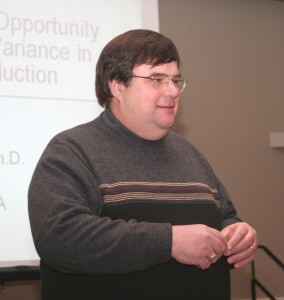 Producers should focus on maximizing the value of the pigs that they sell in order to improve margins, rather than trying to cut costs without understanding the potential consequences, says Dr. Dennis DiPietre, an economist from Missouri. He was speaking at a series of meetings held across Canada, which were organized by Elanco Animal Health. “When people are in survival mode, they make decisions that might look as if they are going to result in a net benefit, but very often they don’t,” he says. “During the 1998-9 pig crisis, one large US production company took all the cell phones away from their staff. What might be the cost of missing just one vital communication?”
Producers should focus on maximizing the value of the pigs that they sell in order to improve margins, rather than trying to cut costs without understanding the potential consequences, says Dr. Dennis DiPietre, an economist from Missouri. He was speaking at a series of meetings held across Canada, which were organized by Elanco Animal Health. “When people are in survival mode, they make decisions that might look as if they are going to result in a net benefit, but very often they don’t,” he says. “During the 1998-9 pig crisis, one large US production company took all the cell phones away from their staff. What might be the cost of missing just one vital communication?”
DiPietre says that herd recording programs focus on sub-systems of production and fail to tie the whole production process together. “That means we lose the idea that the value of the end product is the key thing,” he explains. “For example, weaning age and weight affect growth in the nursery and through to market, but this never used to be considered by the sow farms. Bonus schemes focussed on breeding parameters, not what happened in the nursery. Now the impact is appreciated, producers are investing in more farrowing crates in order to increase weaning age.”
Producers can increase their income by maximizing the number of “Full Value Pigs” that they sell, says DiPietre. He defines these as high health, quality pigs that reach an optimum weight in the desired time to achieve maximum market price. In order to increase the number of Full Value Pigs, it is necessary to know the growth rate of pigs close to market weight and their feed intake. It is also essential to know the relationship between carcass weight and lean percentage in the population of pigs because, as pigs get heavier, their carcass lean reduces, which may have an impact on index and value. The price received for the various weight classes of pig, as defined by the grading grid, must also be known. From all this data, the weight at which net revenue is highest can be calculated and compared with the actual weight of pigs shipped.
“The optimum weight is dependent on the grading grid and also the cost of feed,” DiPietre notes. “The profit-maximizing weight under November 2006 assumptions for the US was 135kg, but today it is only 127kg.”
The number of Full Value Pigs can be increased by moving the average weight of pigs shipped closer to the optimum and by reducing the degree of weight variation. “The greater the variation in weight of pigs shipped, the lower the optimum weight at slaughter,” explains DiPietre. “Therefore, if you can reduce variation, average market weight can be higher, giving more kilos sold and increasing value.” This will also increase the average price received per kilo, he says, because the biggest price discounts are in the extremes of the weight distribution. A tighter weight range will also result in improved feed efficiency and lower feed costs, DiPietre notes.
In addition to improving selection of pigs for market to optimize weight, producers should look for the reasons for variation within their pigs, he believes. This could be related to health challenges, variation in weaning age, variation in throughput and stocking density or variation in feeds. Better management to reduce such variation, such as more timely treatment of health problems, will increase the percentage of Full Value Pigs, DiPietre says. He advises producers to focus on the bottom 30% of pigs because this will have the most impact.
Maximizing the value of the end product will become essential in the new high-cost feed environment, stresses DiPietre. “A doubling of feed prices means that producers will have to deliver more value than in the past,” he says. “This is what will separate those people that are going to be successful in the future and those that aren’t.”









